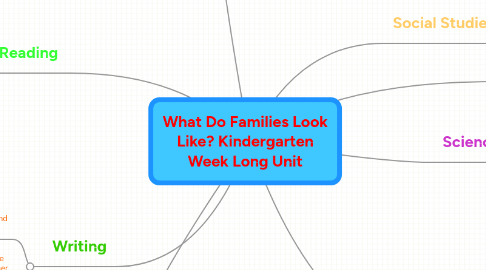
1. Reading
1.1. Comprehension Strategies - Read Books and ask comprehension questions as stated in standards - "Whose Baby am I" & "We Are All Alike, We Are All Different"
1.1.1. S1.C6.PO1 - Make Predictions S1.C6.PO2 - Derive meaning S2.C1.PO2 - Identify story elements S2.C1.PO4 - Identify real vs fantasy
1.2. Syllable Segmentation - "Mother's Glasses" - project on Smart Board - clap syllables as song is played - finger play
1.2.1. S1.C2.PO8 - Segment syllables using manipulatives (hands)
1.3. Rhyme - "Five Little Monkeys" - project on Smart Board - highlight rhyming words together - have kids clap when they hear rhyming words
1.3.1. S1.C2.PO1 - Distinguish spoken rhyming words from non-rhyming words
1.4. Print Concepts - "Whose Baby am I" & "We Are All Alike, We Are All Different"
1.4.1. S1.C1.PO4 - Identify parts of book S1.C1.PO5 - Distinguish between printed letters and words S1.C1.PO8 - Demonstrate one to one correlation between spoken words and print
2. Writing
2.1. Label Family - ask students to draw and label family
2.1.1. S2.C1.PO1 - Use pictures to convey meaning S2.C1.PO3 - Use labels to expand meaning
2.2. Family time - ask students to draw and write what they like to do with their family (teacher assisted)
2.2.1. S2.C1.PO2 - Use pictures with imitative text, letters, or recognizable words to convey meaning
3. Music/Movement
3.1. "I'm Bringing Home a Baby Bumble Bee" by Dr. Jean
3.1.1. K Music S1.C1.PO1 - Exhibit singing voices, K Dance S1.C2.PO101 - Perform basic axial/nonlocomotor movements
3.2. "Growing Up" by Dr. Jean
3.2.1. K Music S1.C1.PO1 - Exhibit singing voices, K Dance S1.C2.PO101 - Perform basic axial/nonlocomotor movements
4. Creative Arts
4.1. Families are Different Project - create a classroom web - ask children how they would like to present their family to class
4.1.1. Collage of photos
4.1.2. Puppets
4.1.3. Family book
4.1.4. Beg. visual arts - S1.C2.PO2 - Experiment with materials, tools and techniques in own artwork
5. Animal math game - puzzle match game
5.1. S4.C2.PO1 Describe that most animals will grow to resemble their parents
6. Social Studies
6.1. How can we help each other? Brainstorm a list together. Have students discuss in small groups and share. Ask students to roll play using family puppets.
6.1.1. S3.C4.PO3 Discuss the importance of students contributing to a community (family)
6.2. What does being part of a family mean? Discuss in pairs and make a web as a class. Role play ways to be responsible and a good family member.
6.2.1. S3.C4.PO2 Recognize the rights and responsibilities of citizenship
7. Science
7.1. Draw and label animal babies and parents - show examples using the internet
7.1.1. S4.C2.PO1 Describe that most animals will grow to resemble their parents
7.2. Adult & Baby Animals Smart Board Site http://www.crickweb.co.uk/assets/resources/flash.php?&file=YoungAnimals
8. Math
8.1. Put the correct number of animal babies next to number - Teacher created Kidspiration activity
8.1.1. S1.C1.PO1 - Make a model to represent a given whole number 0-20.
8.2. Count animal babies & write the number - Small groups with teacher assistance
8.2.1. S1.C1.PO3 - Count forward to 20 S1.C1.PO5 - Write whole numbers to 20
8.3. Draw, count, and compare family members - Small groups with teacher assistance/monitoring
8.3.1. S1.C1.PO3 - Count forward to 20 S1.C1.PO7 - Compare two whole numbers through 20
8.4. Graph how many family members we have on Smart Board - ask questions based on graph
8.4.1. S2.C1.PO1 - Formulate questions to collect data S2.C1.PO3 - Answer questions about pictograph
